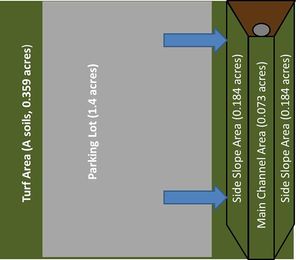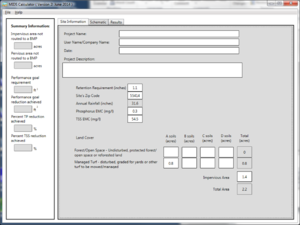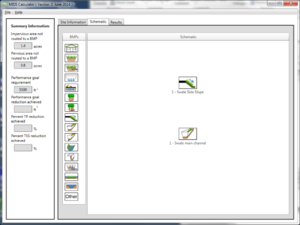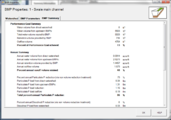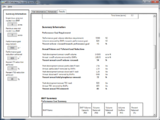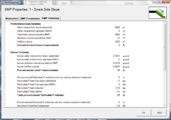
Difference between revisions of "Requirements, recommendations and information for using swale side slope as a BMP in the MIDS calculator"
(Created page with " ==Swale Side Slope== The swale side slope BMP is used in combination with one of the three main channel BMPs (Swale Main Channel, Swale Main Channel (with an underdrain), o...") |
|||
| Line 59: | Line 59: | ||
*The swale side slope has been properly designed, constructed and will be properly maintained according to specifications for filtration systems. | *The swale side slope has been properly designed, constructed and will be properly maintained according to specifications for filtration systems. | ||
*The swale side slope is being used in combination with one of the tree main channel components. | *The swale side slope is being used in combination with one of the tree main channel components. | ||
| + | |||
| + | |||
| + | ==Swale Side Slope and Main Channel Example (Version 2)== | ||
| + | [[File:Swale no underdrain schematic for example.jpg|300px|thumb|left|alt=Schematic used to determine the watershed characteristics of your entire site|<font size=3>Schematic used to determine the watershed characteristics of your entire site</font size>]] | ||
| + | |||
| + | [[File:Swale no underdrain site information tab.png|300px|thumb|alt=Schematic of the site information tab of the MIDS calculator|<font size=3>Schematic of the site information tab of the MIDS calculator</font size>]] | ||
| + | |||
| + | [[File:Swale no underdrain schematic tab.png|300px|thumb|alt=Schematic showing Schematic tab and drag and drop a Swale Side Slope and a Swale Main Channel icon into the Schematic Window|<font size=3>Schematic showing Schematic tab and drag and drop a Swale Side Slope and a Swale Main Channel icon into the Schematic Window</font size>]] | ||
| + | |||
| + | The runoff from a 1.4 acre parking lot surrounded by 0.359 acres of pervious turf area flows through sheet flow over one of the side slopes of a swale and into a swale main channel. The soils across the area have a unified soils classification of SW (HSG type A soil). A second side slope associated with the main channel does not receive runoff from impervious surfaces. Each of the swale side slopes are 800 feet long by 10 feet wide with a side slope of 5H:1V. The main channel of the swale is 800 feet long by 4 feet wide with a 2 percent slope. The swale main channel does not have an underdrain, bioretention base or check dams. The maintenance on the swale calls for mowing once a year. The following steps detail how this system would be set up in the MIDS calculator. | ||
| + | |||
| + | '''Step 1''': Determine the watershed characteristics of your entire site. For this example we have a 2.2 acre site with 1.4 acres of impervious area (parking lot) and 0.8 acres of pervious area in type A soils. The pervious area includes the turf area and the area of the swale side slopes and main channel. | ||
| + | |||
| + | '''Step 2''': Fill in the site specific information into the ''Site Information'' tab. This includes entering a Zip Code (55414 for this example) and the watershed information from Step 1. The Managed Turf area includes the turf area, the area of the side slopes and the area of the main channel. Zip code and impervious area must be filled in or an error message will be generated. Other fields on this screen are optional. | ||
| + | |||
| + | '''Step 3''': Go to the Schematic tab and drag and drop a “Swale Side Slope” and a “Swale Main Channel” icon into the “Schematic Window” | ||
| + | |||
| + | '''Step 4''': Determine the watershed characteristic for each of the BMP components. For this example the swale side slope watershed includes 1.4 acres of impervious area and 0.543 acre of pervious area (0.359 acre of turf area plus 0.184 acre of swale side slope). The watershed of the swale main channel includes the pervious area of the main channel (0.073 acre) and the pervious area of the other swale side slope (0.184 acre) for a total pervious area of 0.257 acre. Since no impervious area is being routed to the second swale side slope, the area can be included in the direct watershed area of the main channel. However, the second swale side slope could be placed in the calculator as an additional BMP. Including it as a separate BMP provides a slightly greater annual volume reduction and more closely represents the true system. | ||
| + | |||
| + | '''Step 5''': Open the BMP properties for the swale side slope by right clicking on the ''Swale Side Slope'' icon and selecting ''Edit BMP properties'', or by double clicking on the ''Swale Side Slope'' icon. | ||
| + | |||
| + | '''Step 6''': Click on the ''Minnesota Stormwater Manual Wiki'' link or the ''Help'' button to review input parameter specifications and calculation specific to the ''Swale Side Slope'' BMP. | ||
| + | |||
| + | '''Step 7''': Fill in the specific BMP watershed information (1.4 acres of impervious and 0.543 acre of Managed Turf on A Soils. Route the side slope BMP to the main channel BMP. | ||
| + | |||
| + | '''Step 8''': Enter in the BMP design parameters into the ''BMP parameters'' tab. Swale Side Slope requires the following entries. | ||
| + | *Side slope [H:V] which is 5:1 | ||
| + | *Flow path length which is 10 feet | ||
| + | *Channel length, which is 800 feet | ||
| + | *Underlying soil – Hydrologic Soil Group, which is 4 SW (HSG A, 1.63 in/hr) | ||
| + | *Manning’s n (vegetation), which is Native grass | ||
| + | |||
| + | <gallery caption="MIDS calculator screen shots. Click on an image for enlarged view." widths="140px"> | ||
| + | File:Swale side slope watershed tab.png|alt=Schematic showing tab used to fill in specific BMP watershed information|Schematic showing tab used to fill in specific BMP watershed information | ||
| + | File:Swale side slope BMP parameters tab.png|alt=Schematic showing results from entering BMP design parameters into the BMP parameters tab|Schematic showing results from entering BMP design parameters into the BMP parameters tab | ||
| + | File:Swale main channel watershed tab.png|alt=Schematic showing tab used to fill in specific BMP watershed information|Schematic showing tab used to fill in specific BMP watershed information | ||
| + | File:Swale main channel watershed tab 2.png|alt=Schematic showing tab used to fill in specific BMP watershed information|Schematic showing tab used to fill in specific BMP watershed information | ||
| + | File:Swale main channel BMP parameters tab.png|alt=Schematic showing tab used to fill in specific BMP watershed information|Schematic showing tab used to fill in specific BMP watershed information | ||
| + | </gallery> | ||
| + | |||
| + | <gallery caption="MIDS calculator screen shots of results and summary tabs. Click on an image for enlarged view." widths="200px"> | ||
| + | File:swale main channel BMP summary tab 1.png|alt=Schematic showing screen used to enter BMP design parameters into the BMP parameters tab|Schematic showing screen used to enter BMP design parameters into the BMP parameters | ||
| + | File:swale main channel BMP summary tab 2.png|alt=Schematic showing screen used to enter BMP design parameters into the BMP parameters tab|Schematic showing screen used to enter BMP design parameters into the BMP parameters | ||
| + | File:swale side slope results tab 1.png|alt=Schematic showing screen used to enter BMP design parameters into the BMP parameters tab|Schematic showing screen used to enter BMP design parameters into the BMP parameters | ||
| + | </gallery> | ||
| + | |||
| + | '''Step 9''': Click on ''BMP Summary'' tab to view results for this BMP. | ||
| + | |||
| + | '''Step 10''': Click on the ''OK'' button to exit the BMP properties screen. An arrow will appear showing that the swale side slope has been routed to the swale main channel. | ||
| + | |||
| + | '''Step 11''': Open the BMP properties window for the swale main channel by right clicking on the ''Swale main channel'' icon and selecting ''Edit BMP properties'', or by double clicking on the “Swale main channel” icon. | ||
| + | Step 12: Click on the ''Minnesota Stormwater Manual Wiki'' link or the ''Help'' button to review input parameter specifications and calculation specific to the ''Swale main channel'' BMP. | ||
| + | |||
| + | '''Step 13''': Enter in the watershed information for the swale main channel in the ''Watershed'' tab (0.257 acre for Pervious Turf on A Soil which includes the area of the main channel and the other side slope). | ||
| + | |||
| + | '''Step 14''': Enter in the BMP design parameters into the ''BMP parameters'' tab. Swale main channel requires the following entries. | ||
| + | *Channel length, which is 800 feet | ||
| + | *Swale bottom width, which is 4 feet | ||
| + | *Channel slope, which is 2 percent (%) | ||
| + | *Underlying soil – Hydrologic Soil Group, which is 4 SW (HSG A, 1.63 in/hr) | ||
| + | *Manning’s n (vegetation), which is native grass | ||
| + | *Does the swale have a check dam, which is no | ||
| + | *Does the swale have a bioretention base, which is no | ||
| + | |||
| + | '''Step 15''': Click on ''BMP Summary'' tab to view results for this BMP. | ||
| + | |||
| + | '''Step 16''': Click on the ''OK'' button to exit the BMP properties screen. | ||
| + | |||
| + | '''Step 17''': Click on ''Results'' tab to see overall results for the site. | ||
Revision as of 21:59, 4 August 2014
Swale Side Slope
The swale side slope BMP is used in combination with one of the three main channel BMPs (Swale Main Channel, Swale Main Channel (with an underdrain), or Wet Swale). This BMP should not be used as a standalone BMP as the credits were determined as part of a swale system. The swale side slope must receive stormwater runoff from the direct watershed through sheet flow over the entire channel length. If the stormwater flow is channelized when it reaches the swale side slope, the swale main channel component should be used without the swale side slope component. The swale side slope BMP represents one side slope of a swale system. If a swale contains two side slopes that each receives runoff through sheet flow from impervious surfaces, two swale side slopes should be used in the calculator and routed to the corresponding swale main channel BMP. Credit toward the performance goal for a swale side slope is given based on infiltration into the soils. Due to the fact that the performance goal is an instantaneous credit following the kerplunk method, a relationship between an annual volume reduction and the instantaneous credit was created. All pollutants in the infiltrated water are credited as being reduced.
MIDS calculator user inputs for swale side slope
For swale side slope BMPs, the user must input the following parameters to calculate the stormwater volume and pollutant load reductions.
- Watershed tab
- BMP Name: this cell is auto-filled but can be changed by the user.
- Routing/downstream BMP: if this BMP is part of a swale system and water is being routed from this BMP to a main channel swale, the user selects the name of the BMP from the dropdown box to which water is being routed. All water must be routed to a single BMP. Note that the user must include the BMP receiving the routed water in the Schematic tab or the BMP will not appear in the dropdown box. This BMP can only be routed to a main channel swale.
- BMP Watershed Area: BMP watershed areas are the areas draining directly to the BMP. Values can be added for four soil types (Hydrologic Soil Groups (HSG) A, B, C, D) and for three Land Cover types (Forest/Open Space, Managed Turf and impervious). The surface area of the BMP should be included as a managed turf land cover under the hydrologic soils group of the native soils located under the BMP. Units are in acres.
- BMP Parameters tab
- Side slope [H:V]: The user selects from a drop down menu the ratio between the horizontal (H) and vertical (V) components of the side slope (H:V). The values available for selection are 3:1, 4:1, 5:1, 6:1, and 7:1. By selecting a horizontal to vertical side slope ratio, the corresponding “Side slope” (%) will populate automatically. This value should be an average for the length of the swale.
- Flow path length: This is the average horizontal distance between the highest elevation point and lowest elevation point of the side slope perpendicular to the main channel throughout the length of the swale. This could also be described as the width of the side slope. Units are in feet.
- Channel length: This is the length of the side slope from the farthest point upstream to the farthest point downstream of the main channel. Flow must be sheet flow over the entire channel length (if not, channel length should be adjusted to only cover areas where sheet flow occurs). Units are in feet.
- Underlying soil - Hydrologic Soil Group: The user selects the most restrictive soil (lowest hydraulic conductivity) within three feet of the soil surface of the swale side slope. There are 14 soil options that fall into 4 different Hydrologic Soil Groups (Hydrologic Soil Group (HSG) A, B, C, or D) for the user. These correspond with soils and infiltration rates contained in this Manual. Once a soil type is selected, the corresponding infiltration rate will populate in the “Infiltration rate of underlying soils” field. The user may also select “User Defined.” This selection will activate the “User defined infiltration rate” cell allowing the user to enter a different value from the value in the predefined selection list. The maximum allowable infiltration rate is 1.63 inches per hour.
- Manning’s n (Vegetation): The user selects a type of vegetation cover on the swale side slope, which populates a corresponding Manning’s n. The vegetation types are mowed turf or native grasses. Mowed turf would be selected if the side slope is mowed on a consistent basis. Native grasses would be selected if the side slope is left to grow or is mowed infrequently. Once a vegetation cover is selected, the corresponding Manning’s n will populate in the “Manning’s n” field. The user may also select “User Defined.” This selection will activate the “User Defined Manning’s n” cell allowing the user to enter a value different from the values in the predefined selection list.
- BMP Summary Tab: The BMP Summary tab summarizes the volume and pollutant reductions provided by the specific BMP. It details the performance goal volume reductions and annual average volume, dissolved P, particulate P, and TSS load reductions. Included in the summary are the total volume and pollutant loads received by the BMP from its direct watershed, from upstream BMPs and a combined value of the two. Also included in the summary, are the volume and pollutant load reductions provided by the BMP, in addition to the volume and pollutant loads that exit the BMP through the outflow. This outflow load and volume is what is routed to the downstream BMP if one is defined in the Watershed tab. Finally, percent reductions are provided for the percent of the performance goal achieved, percent annual runoff volume retained, total percent annual particulate phosphorus reduction, total percent annual dissolved phosphorus reduction, total percent annual TP reduction, and total percent annual TSS reduction.
Model input requirements and recommendations
The following are requirements for inputs into the MIDS calculator. If the following are not met, an error message will inform the user to change the input to meet the requirement.
- Infiltration rates of the underlying soils are restricted to being below 1.63 inches/hour.
- The Manning’s n value must be less than or equal to 1.
Methodology
Required Treatment Volume
“Required treatment volume,” or the volume of stormwater runoff delivered to the BMP, equals the performance goal (1.1 inches or user-specified performance goal) times the impervious area draining to the BMP. Since no BMP can be routed to a swale side slope, no additional water can be routed to the swale side slope from an upstream BMP. Stormwater is delivered to the BMP instantaneously following the Kerplunk method.
Volume Reduction
The volume reduction achieved by a BMP compares the capacity of the BMP to the required treatment volume. The “Volume reduction capacity of BMP [V]” is calculated using BMP inputs provided by the user. A swale side slope does not have storage capacity similar to other BMPs in the MIDS calculator. Volume reduction occurs through infiltration as the stormwater travels over the side slope. To obtain an instantaneous stormwater volume credit for a swale side slope, annual volume reductions were determined and converted to a volume retention capacity credit that follows the Kerplunk method.
To determine the volume loss credit given for a swale side slope, the P8 water quality model was used. 55 years of hourly rainfall data were modeled for swale side slopes with various configurations of side slope, flow path length, channel length, soil infiltration rate and Manning’s n parameters. The model results provided annual average volume reduction rates. The model results were used to create relationships between the swale modeling parameters and annual percent stormwater volume reductions using multivariate regression. The developed relationship is used with the user provided inputs to calculate an annual percent stormwater volume reduction for the swale side slope in the calculator.
The next step is to convert the annual percent stormwater volume reduction to an instantaneous stormwater volume reduction that follows the Kerplunk method used for other BMPs. This is accomplished through the use of performance curves developed from multiple modeling scenarios. The performance curves use the annual volume reduction percentage, the infiltration rate of the underlying soils, the contributing watershed percent impervious area, and the size of the contributing watershed to calculate the “Volume reduction capacity of BMP [V]”.
The “Volume of retention provided by BMP” is the amount of volume credit the BMP provides toward the performance goal. This value is equal to the “Volume reduction capacity of BMP [V]”, calculated using the above method, as long as the volume reduction capacity is less than or equal to the “Required treatment volume.” If the volume reduction capacity is greater than “Required treatment volume”, then the BMP volume credit is equal to “Required treatment volume.” This check makes sure that the BMP is not getting more credit than the amount of water it receives. For example, if the BMP is oversized the user will only receive credit for “Required treatment volume” routed to the BMP.
Pollutant Reduction=
Pollutant load reductions are calculated on an annual basis. For this BMP, pollutant reduction is provided through infiltration only. The annual volume reduction is calculated using the relationship between the P8 modeling results and the swale design parameters discussed in the volume reduction section. A 100 percent pollutant removal rate is applied to the stormwater infiltrated on an annual basis for total suspended solids, dissolved phosphorus, and particulate phosphorus. Pollutants not removed through infiltration are routed to the downstream swale main channel.
NOTE: The user can modify event mean concentrations (EMCs) on the Site Information tab in the calculator. Default concentrations are 54.5 milligrams per liter for total suspended solids (TSS) and 0.3 milligrams per liter for total phosphorus (particulate plus dissolved). The calculator will notify the user if the default is changed. Changing the default EMC will result in changes to the total pounds of pollutant reduced.
Routing
The swale side slope BMP is designed to be part of a system with a corresponding swale main channel BMP. Therefore, a swale side slope BMP can only be routed to one of the three main channel BMPs: Swale Main Channel, Swale Main Channel (with underdrain), or Wet Swale. The swale side slope BMP should not be used as a standalone BMP. It should always be used in combination with one of the three main channel BMPs. The swale side slope BMP requires sheet flow over its surface area to receive credit. Therefore, no other BMP can be routed to the swale side slope BMP. It can only receive runoff from the direct watershed.
Assumptions for swale side slope
The following general assumption applies in calculating the credits for a swale side slope. If this assumption is not followed, the volume and pollutant reduction credits cannot be applied.
- The swale side slope has been properly designed, constructed and will be properly maintained according to specifications for filtration systems.
- The swale side slope is being used in combination with one of the tree main channel components.
Swale Side Slope and Main Channel Example (Version 2)
The runoff from a 1.4 acre parking lot surrounded by 0.359 acres of pervious turf area flows through sheet flow over one of the side slopes of a swale and into a swale main channel. The soils across the area have a unified soils classification of SW (HSG type A soil). A second side slope associated with the main channel does not receive runoff from impervious surfaces. Each of the swale side slopes are 800 feet long by 10 feet wide with a side slope of 5H:1V. The main channel of the swale is 800 feet long by 4 feet wide with a 2 percent slope. The swale main channel does not have an underdrain, bioretention base or check dams. The maintenance on the swale calls for mowing once a year. The following steps detail how this system would be set up in the MIDS calculator.
Step 1: Determine the watershed characteristics of your entire site. For this example we have a 2.2 acre site with 1.4 acres of impervious area (parking lot) and 0.8 acres of pervious area in type A soils. The pervious area includes the turf area and the area of the swale side slopes and main channel.
Step 2: Fill in the site specific information into the Site Information tab. This includes entering a Zip Code (55414 for this example) and the watershed information from Step 1. The Managed Turf area includes the turf area, the area of the side slopes and the area of the main channel. Zip code and impervious area must be filled in or an error message will be generated. Other fields on this screen are optional.
Step 3: Go to the Schematic tab and drag and drop a “Swale Side Slope” and a “Swale Main Channel” icon into the “Schematic Window”
Step 4: Determine the watershed characteristic for each of the BMP components. For this example the swale side slope watershed includes 1.4 acres of impervious area and 0.543 acre of pervious area (0.359 acre of turf area plus 0.184 acre of swale side slope). The watershed of the swale main channel includes the pervious area of the main channel (0.073 acre) and the pervious area of the other swale side slope (0.184 acre) for a total pervious area of 0.257 acre. Since no impervious area is being routed to the second swale side slope, the area can be included in the direct watershed area of the main channel. However, the second swale side slope could be placed in the calculator as an additional BMP. Including it as a separate BMP provides a slightly greater annual volume reduction and more closely represents the true system.
Step 5: Open the BMP properties for the swale side slope by right clicking on the Swale Side Slope icon and selecting Edit BMP properties, or by double clicking on the Swale Side Slope icon.
Step 6: Click on the Minnesota Stormwater Manual Wiki link or the Help button to review input parameter specifications and calculation specific to the Swale Side Slope BMP.
Step 7: Fill in the specific BMP watershed information (1.4 acres of impervious and 0.543 acre of Managed Turf on A Soils. Route the side slope BMP to the main channel BMP.
Step 8: Enter in the BMP design parameters into the BMP parameters tab. Swale Side Slope requires the following entries.
- Side slope [H:V] which is 5:1
- Flow path length which is 10 feet
- Channel length, which is 800 feet
- Underlying soil – Hydrologic Soil Group, which is 4 SW (HSG A, 1.63 in/hr)
- Manning’s n (vegetation), which is Native grass
- MIDS calculator screen shots. Click on an image for enlarged view.
- MIDS calculator screen shots of results and summary tabs. Click on an image for enlarged view.
Step 9: Click on BMP Summary tab to view results for this BMP.
Step 10: Click on the OK button to exit the BMP properties screen. An arrow will appear showing that the swale side slope has been routed to the swale main channel.
Step 11: Open the BMP properties window for the swale main channel by right clicking on the Swale main channel icon and selecting Edit BMP properties, or by double clicking on the “Swale main channel” icon. Step 12: Click on the Minnesota Stormwater Manual Wiki link or the Help button to review input parameter specifications and calculation specific to the Swale main channel BMP.
Step 13: Enter in the watershed information for the swale main channel in the Watershed tab (0.257 acre for Pervious Turf on A Soil which includes the area of the main channel and the other side slope).
Step 14: Enter in the BMP design parameters into the BMP parameters tab. Swale main channel requires the following entries.
- Channel length, which is 800 feet
- Swale bottom width, which is 4 feet
- Channel slope, which is 2 percent (%)
- Underlying soil – Hydrologic Soil Group, which is 4 SW (HSG A, 1.63 in/hr)
- Manning’s n (vegetation), which is native grass
- Does the swale have a check dam, which is no
- Does the swale have a bioretention base, which is no
Step 15: Click on BMP Summary tab to view results for this BMP.
Step 16: Click on the OK button to exit the BMP properties screen.
Step 17: Click on Results tab to see overall results for the site.
